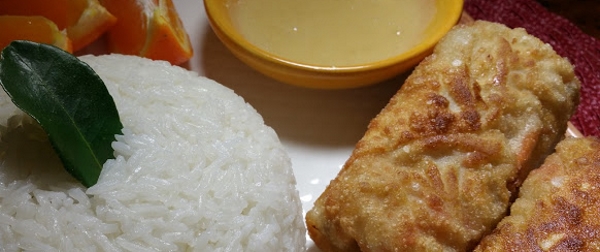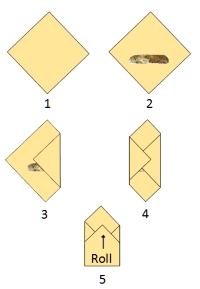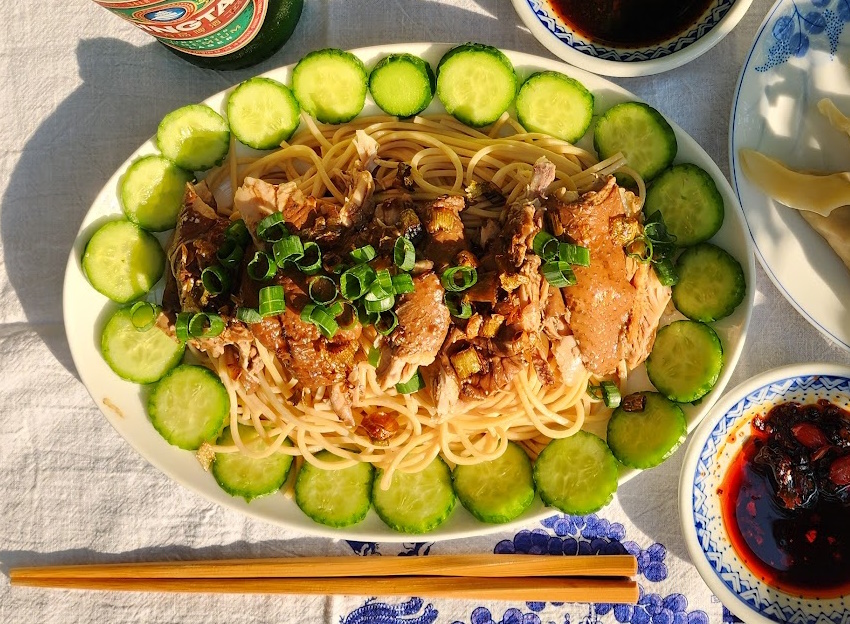The Participant Observer recipe of the month is for Chinese-American Egg Rolls. A staple of older Chinese-American restaurants (and some new ones!), you can make superior egg rolls at home if you follow our simple directions.

Egg Rolls and Rice
Today, according to the Chinese American Restaurant Association, there are over 45,000 Chinese restaurants currently in operation across the United States. This number is greater than all the McDonald's, KFCs, Pizza Huts, Taco Bells and Wendy's combined. When asked to rank their favorite types of restaurants, Chinese places almost always come out on top—Food historian, Emelyn Rude
While New York and San Francisco and other large cities are known to have vibrant Chinatown neighborhoods, Chinese restaurants can be found in even the smallest towns from coast to coast. Many years ago most Chinese restaurant dishes were derived from southern Chinese Cantonese style. One of the mainstays in Chinese-American food is, of course, the egg roll. Egg rolls owe their origin to the Chinese spring roll known as cha chuen guen (fried circle roll), but they are considerably bigger than a Chinese spring roll.
Chinese food arrived in America with the California gold rush in the late 1840s. In subsequent years Chinese restaurants became very popular in San Francisco. As many of the immigrants came from the port city of Canton, the cuisine brought from China was largely Cantonese. Chop Suey, although it has a faint connection to any Chinese dish in China, became extremely popular in many urban areas in America. The Chinese Exclusion Act of 1852, which was only overturned in 1943, ended Chinese immigration and cut off American Chinese from their homeland. It seems probable that this resulted in Chinese-American cuisine developing along its own unique lines. Although they may have had their origins in Japan, fortune cookies became very popular in San Francisco and elsewhere in the 20th century. It wasn't until the mid 1960s, due to the arrival of new immigrants from China, that regional cuisines from other parts of China were introduced in America.
Nowadays in more cosmopolitan cities a wide variety of Chinese cuisine can be found that has its origins in the provinces of Hunan, Sichuan, Shanghai, Beijing, etc. Add to this dishes from Hong Kong, Taiwan and Singapore and now one can enjoy a great variety of Chinese specialties. More traditional Chinese-American food tends to be mild unlike the fiery-hot dishes from Hunan and Sichuan. Again, it is important to note that by this point in history traditional Chinese-American cuisine is a cuisine in and of itself, and perhaps we can even conceive of something so bold as "Authentic American-Chinese." Chop suey, Moo Goo Gaipan, General Tso's Chicken, Chow Mein, Moo-shoo pork, Egg Foo Yung along with Hot-Sour or Wonton Soup. All of these dishes are derived from Chinese dishes (however obliquely), but over the course of time they have certainly changed and become a cuisine unto itself. Purists may turn their noses up at the food not being "authentic", but really from an anthropological view, all food undergoes changes through contact with other cultures and when it is exported to other cultures. "Authenticity" is a concept that is intellectually difficult to defend over the course of centuries and years. At least one source says that Chinese-American egg rolls were first introduced in the 1930s in New York City.
I was introduced to the egg roll when I was a child in the early 1960s when my family dined at Lum Fong's in Jekintown, Pennsylvania. I remember Moo Goo Gai Pan and Moo Shu Pork—and the best egg rolls I've ever had! This was also the start of my life-long love of rice. Back then eating egg rolls with hot mustard was the thing to do. More recently sweet and sour sauce has also become an option. The egg rolls at Lum Fong's were crunchy on the outside and the vegetables (cabbage, bean sprouts and carrots) inside still had some crunch to them. From memory I've tried to replicate them and it has taken me several tries. Before I prepare recipe of the month dishes I look at as many versions as I can find so that I can hone in on what are the most essential ingredients and preparation methods. I confess I am more motivated by making something that tastes good than a dish that is "authentic" but happily, in most cases, versions that are more authentic often do taste the best as they have stood the test of time.
 |
Rolling up an egg roll is rather straight-forward once you get the hang of it. After you prepare the filling, slightly crack an egg over a bowl and let the egg white flow out. If you don't intend to use the yolk for anything else, this is the easiest, quickest and least messy method. Egg whites tend to stick together so give them a quick whisk to make them a bit more liquid (just a little!). On a dry cutting board, lay one skin down so that it looks like a diamond, with one corner pointing towards you. Grab a handful of filling and place it lengthwise left to right slightly below the center line. With a bit of experimentation you will discover the proper amount of filling to use. Then moisten the right corner of the skin with a little egg. You can use a brush or your fingers. If you are left-handed you might want to start on the opposite corner. Then lift and pull the left-hand corner over the filling until it is a quarter inch across the center line. Do the same with the right hand corner and "glue" it to the left hand corner. It will hold together. Then you will take the corner closest to you and fold it over the filling to the point that the skin from the lower corner touches the side corners. By doing this you will learn which edges require the egg treatment. Try to make the best seal you can. Paint the top corner (and along the sides) of the skin with egg. Then you should place both your hands over the egg roll so that your fingers curl over the egg roll and your finger tips come to rest on the top edge of the filling. This next step requires three separate actions at the same time (no worries, it's easy). Curl your fingers toward you and at the same time start rolling the edge of the egg roll closest to you towards the top all the while exerting downward pressure on the egg roll. Do this until you roll over the top corner. If you use a single skin it is possible that you will make a tear somewhere; this should be patched. Just tear off a small piece from the top corner of your next skin, dab a bit of egg on it and patch the tear. |
Most fried foods do best when fried at 350 degrees. Egg rolls are no exception. If the oil is too hot, the inside surface of the wrappers will still be doughy. That's what happened the first time I tried to make egg rolls. If you cook the egg rolls at a lower temperature (like 325), you will have more control over the cooking (as it will be slower) but the interior ingredients may be overcooked and mushy. It is perhaps best to cook in oil that is deep enough to submerge the entire egg roll but you can use less oil if you turn the egg roll as it cooks. If your oil comes up the center line of the roll, you may only have to turn the egg roll once. I experimented with not cooking the vegetables first (as I like a bit of crunch) but unfortunately this does not work out because if uncooked the vegetables will shrink when the egg roll is fried and then your egg roll will not be tight. After you pre-cook the vegetables, drain them with a large strainer. You might even consider pressing them a bit with your hand or some other implement to get out as much moisture as possible.
As mentioned above, in my youth I ate egg rolls with Chinese hot mustard. Store bought pre-prepared Chinese mustard often has ingredients that make it somewhat gelatinous. You can make your own quite easily. The basic recipe is to mix 1 part dry mustard powder with one part mustard and then let it sit for 15 minutes to an hour to develop the taste. Coleman's dry mustard, available in any supermarket, is a little less hot than Chinese dry mustard but only a little. Some people add a bit of oil to make the mustard smoother and some substitute half the water with the same amount of vinegar which tones down the heat a bit. The flavor of hot mustard decreases over time, another reason to make it yourself and avoid the pre-prepared kind. Almost all of the little plastic packets of mustard are simply horrible although recently we found one brand that was not bad at all (but not very hot).
Egg rolls are usually eaten as an appetizer. But served alongside some rice, they can also be enjoyed as a meal. This recipe calls for pork and shrimp, perhaps the most common style, but chicken can be substituted.
Ingredients:
- 1/2 Pound diced (small) pork
- 10 Medium shrimp
- 1-Inch grated fresh ginger
- 2 Cloves garlic, finely chopped
- 4 Scallions (green onions), sliced thinly
- 1 can of water chestnuts diced small
- 1/2 Cup julienned carrots
- 1/4 Cup red bell pepper jullenned
- 2 Cups mung bean sprouts
- 2 Cups shredded Napa cabbage
- 2 Tablespoons fish sauce (optional)
- 2 Tablespoons soy sauce
- 2 Tablespoons sesame oil
- 1 Package egg roll wrappers
- 1 Tablespoon hot dry mustard powder
- 1 Egg lightly whisked
- Oil for deep fat frying (I prefer peanut oil but canola or light olive oil can be used too)
- 1 Cup of rice (optional)
Preparation:
- Start cooking rice.
- In a small bowl, thoroughly mix 1 tablespoon of dry mustard with 1 tablespoon of water and set asid.e
- Fry pork with garlic in a small amount of sesame oil. When almost cooked add fish sauce and cook until there is no more liquid.
- Fry or boil shrimp until cooked. If using shell-on shrimp, remove the shells before cooking and add shells to water or oil for enhanced flavor.
- Separate shells from shrimp and discard the shells.
- Cut the shrimp into 1/3 of an inch pieces.
- Mix pork, shrimp ginger, scallions, carrots, bell peppers, sprouts, water chestnuts, bean sprouts, Napa cabbage, soy sauce and sesame oil in a large skillet.
- On medium high cook filling in a small amount of oil for five minutes turning constantly
- Put filling in a large strainer (over a pot or bowl) and drain thoroughly. Push down on the mixture (with hand or bottom of a large clean jar) to squeeze out as much moisture as possible.
- Fill each wrapper with a small handful of filling and fold according to directions above.
- Fry each egg roll in hot oil (350°F)until golden brown. Only do a couple at a time, don't crowd them.
- Remove fried egg rolls from oil and drain on a wire rack.
- Serve as appetizer, or as a meal with rice.
Cook's notes:
- Make sure your egg rolls are well sealed so cooking oil doesn't seep inside.
- Opinions vary as to what to seal the egg roll with. Some say egg whites, others say to use yolks, others recommend whole eggs and still some just use plain water. We found egg (whatever parts) work better than water.
- If you are watching your fat consumption, you can "dry" the egg rolls with paper towels after they have drained on a rack. If you drain them with paper towels they will not be as crispy.
Enjoy!
Recipe by: T. Johnston-O'Neill
Photo by: Shari Johnston-O'Neill









